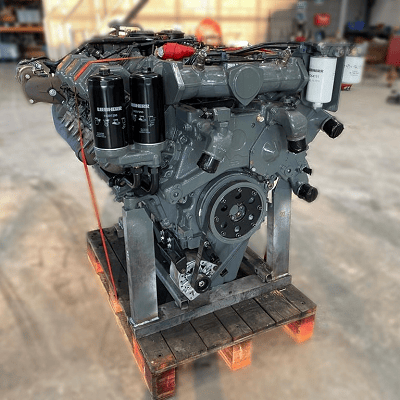The process of a dyno test on a Liebherr engine
The process of a dyno test on a Liebherr engine

When it comes to heavy machinery, reliability and power are paramount. Liebherr, a name synonymous with innovation and excellence in engineering, stands tall as a pioneer in the realm of heavy equipment and machinery. From towering cranes to robust excavators, Liebherr’s engineering prowess extends to the heart of these machines. We delve into the world of dyno testing a Liebherr engine, uncovering the meticulous process behind unleashing the raw power concealed within.
The foundation of excellence
Before we embark on the journey of dyno testing, it’s crucial to understand the foundation upon which Liebherr engines are built. With decades of engineering expertise and commitment to quality, Liebherr engines are crafted to withstand the most demanding environment and deliver unparalleled performance. Each component is meticulously designed and rigorously tested to ensure reliability, efficiency and longevity.
The process
1 Preparation: The engine undergoes meticulous preparation before being mounted onto the dynamo meter. This includes ensuring all connections are secure, fluids are filled to the appropriate levels, and sensors are properly calibrated.
2 Mounting: The engine is carefully mounted onto the dynamometer, a specialized device designed to simulate real-world operating conditions. Precision is paramount during this step to ensure accurate results.
3 Initial checks: Once mounted, a series of initial checks are conducted to verify proper alignment, connection integrity, and functionality of all engine systems.
4 Warm-up: The engine is started and allowed to warm up to operating temperature. This ensures consistent results and minimizes the risk of damage during testing.
5 Baseline testing: With the engine warmed up , baseline tests are conducted to establish initial performance metrics. This includes measuring power output, torque, fuel consumption, and emissions at various RPM levels.
6 Load testing: The engine is subjected to progressively increasing loads to simulate different operating conditions, such as idle, partial load and full load. This allows engineers to assess performance across the entire operating range and identify any potential issues or optimization.
7 Data analysis: Throughout the testing process, data is continuously collected and analyzed in real-time. Advanced instrumentation and software are used to monitor performance metrics and identify trends or anomalies.
8 Optimazation: Based on the data analysis, adjustments may be made to optimize engine performance. This could involve fine-tuning fuel injection timing, adjusting air-fuel ratios, or optimize turbocharger boost pressure.
9 Validation: Once testing is complete, the results are meticulously reviewed and validated against predetermined criteria and specifications. Any deviations or anomalies are thoroughly investigated to ensure accuracy and reliability.
10 Reporting: Finally, a comprehensive report is generated detailing the results of the dyno testing, including performance metrics, observations, and any recommendations for further optimization or refinement.
The outcome of dyno testing
Dyno testing a Liebherr engine is more than just a routine procedure – it’s a testament to the unwavering commitment to excellence that defines Liebherr’s engineering philosophy. By subjecting their engines to rigorous testing and analysis, Liebherr ensures that each engine delivers the uncompromising performance, reliability, and efficiency that customers expect.
In conclusion, dyno testing a Liebherr engine is not just about measuring power output. It’s about unlocking the true potential of these remarkable engines and ensuring they exceed expectations in the most challenging environments imaginable.
Discover our cutting-edge Mobile Emergency Lighting Systems, designed to provide reliable illumination in times of need. Our comprehensive range includes:
1. **Mobile Emergency Lighting System**: Engineered for rapid deployment during emergencies, this system offers high-intensity light to ensure visibility and safety in critical situations.
2. **Light Tower**: Our portable Light Towers are perfect for temporary lighting needs, whether for construction sites, events, or emergency response. They are easy to set up and provide a wide coverage area.
3. **Mobile Light Tower**: Designed for mobility, our Mobile Light Towers can be easily transported to various locations. They are equipped with durable wheels and handles for convenience.
4. **Light System**: Our versatile Light Systems are suitable for a wide range of applications, from outdoor events to industrial use. They offer adjustable brightness and focus for customized lighting solutions.
5. **LED Light Tower**: Featuring energy-efficient LED technology, our LED Light Towers provide bright, long-lasting illumination with minimal energy consumption.
6. **Self-Contained Lighting Tower**: These towers are fully self-contained, with integrated power sources and control systems, ensuring they can operate independently for extended periods.
7. **Illumination Equipment**: Our Illumination Equipment is designed for durability and performance, offering a variety of lighting options to suit different environments and requirements.
8. **High Mast Lighting**: Ideal for large-scale projects and wide-area illumination, our High Mast Lighting systems provide powerful, focused light from elevated positions.
All our lighting solutions are built with robust construction and advanced technology to ensure they deliver optimal performance in any situation. Whether you need temporary or permanent lighting, our systems are designed to meet your needs.
Emergency Lights,Portable Light Towers,mobile light tower,Adjustable Focus Industrial Lighting Systems
Henan Lukewei Road Machinery Manufacturing Co.,Ltd , https://www.lukeweimachinery.com